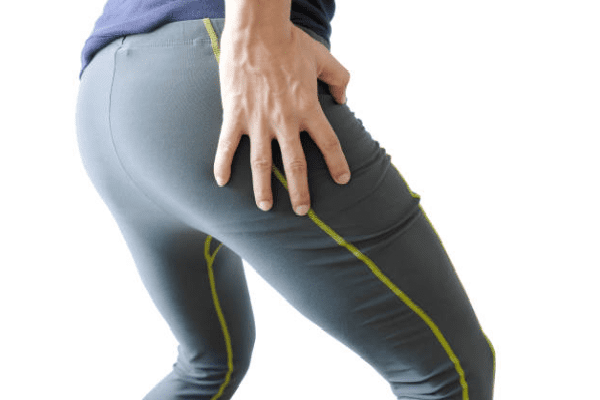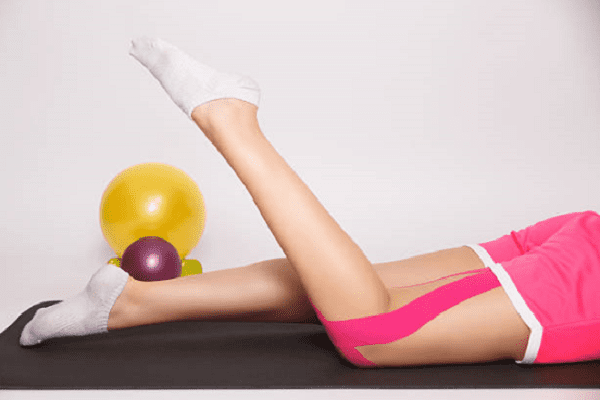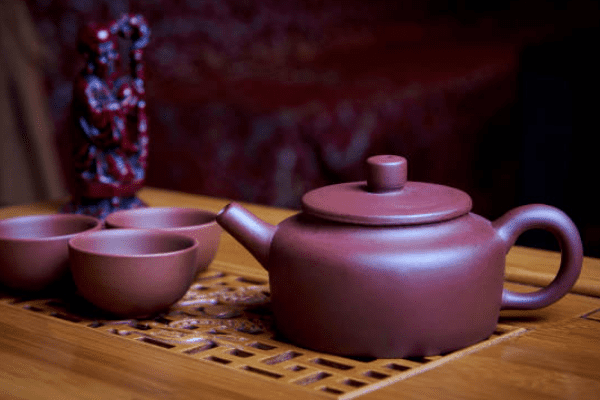Therapeutic exercises >>>> Stretching the gluteus maximus is a recovery exercise
Stretching the gluteus maximus is a recovery exercise.

An injury such as a rupture or sprain of the gluteus muscle is familiar to few. But those who strive to independently stretch their legs and sit on the twine, lift the weight of a barbell or kettlebell in excess of that for which the muscular frame is trained, should get acquainted with this type of possible injury in order to avoid it or know how to treat it.
The gluteus muscle is one of the most developed muscles, since a person involuntarily uses its services throughout his life. But not at the moments of sitting on it, but at the moments when he straightens his torso from a tilt position with straight legs, when with a load in his hands he tries to squat down or stand up from a “squatting” position with a load, or when he simply pulls his leg to the side, doing wide step left-right. Our upright posture is the every second result of the work of the gluteus muscle, our upright posture is also provided by the work of the gluteus muscle. Football fans tend to put a strain on the gluteus muscle when they regularly swing the ball to hit the ball, taking the leg back. In general, even in a normal everyday situation, you can easily pump up the gluteus muscle, and accidentally get it injured.
It is worth knowing that stretching and tearing the gluteal muscle is a very painful phenomenon. A person almost temporarily loses the opportunity to stand, sit, bend or move their legs (thighs) for a long time, not to mention walking. Getting out of bed (sofa), as well as lying on the latter, there is no way to do it painlessly, because in this case, one way or another, you have to bend the body in the lumbar region, where the gluteus muscle is attached. The pain is felt along the back of the thigh or the side of the thigh, and may also hurt inside the buttocks and thighs. The pain can radiate to the lower back, sacrum or coccyx and is very similar to pain when the sciatic nerve is pinched. So it is only a neuropathologist who can correctly diagnose what exactly happened - a tear of the gluteus muscle or an infringement of the sciatic nerve,
What if you realize you've pulled your gluteus muscle? In addition to lying on your back, it will be difficult to take a lying position on your side or on your stomach - painful. The recovery period begins after a decrease in acute pain sensations. For this, home or professional physiotherapy is carried out - warming up the deep layers of the muscles in the buttocks and thighs, with unbearable pain, ointments, tablets and / or injections of anti-inflammatory, muscle relaxants and analgesics are prescribed.

When the pain syndrome subsides, it is necessary to proceed to the restoration of the gluteus muscle after stretching or rupture.
They begin to load the gluteus muscle in the supine position.
Exercise 1. Lying on your back with straight legs, slowly bend your knees (each leg in the knee alternately), without lifting your legs from the surface, and slowly unbend your knees, straightening them to the starting position. The exercise begins with one approach 5-10 times and daily add one approach and increase the number of times to 15.
Exercise 2. Lying on one of the sides (on the side that is pulled), slowly bend the opposite leg at the knee and straighten it to its original position. Exercise begins with 5-10 times in one approach and daily add one approach and increase the number of flexions up to 15 times in one approach.
Exercise 3. Lying on the side opposite to the stretched buttock, slowly bend the leg at the knee (the leg from which the buttock muscle is pulled) and slowly unbend to the starting position. The exercise is repeated 5-10 times in one approach, increasing the number of approaches daily by one.
Exercise 4. Lying on your back with straight legs, slowly pull aside the straight leg (without lifting it from the surface), opposite to the one on the side of which the gluteus muscle is injured. Slowly return the leg to its original position. The exercise is repeated daily, one or more approaches 5-10 times per approach.
Exercise 5. Lying on your back with straight legs, take a straight leg at a very slow pace from the side of the injured muscle to the side, without lifting it off the surface. Very slowly return the leg to its original position. The exercise is repeated in one or more approaches 5-10 times in one approach. Increase the load for one approach every day.
Exercise 6. Lying on your back with straight legs and without lifting your legs from the surface, at a slow pace spread your legs to the sides and bring your legs back to the starting position. 5-10 times in one approach daily, plus one additional approach.
Exercise 7. Lying on your back, at a very slow pace (not overcoming the pain, but stopping the movement of the leg in case of pain), lift the straight leg opposite to the one from which the gluteus muscle is injured. The exercise is carried out in one go 5-10 times and one approach is added daily, bringing the number of leg raises to 15 in one approach.
Exercise 8. Lying on your back, raise the straightened leg at a very slow pace on the side where the gluteus muscle is stretched, and very slowly lower it. Raising the leg is suspended if a pain symptom begins to develop. The exercise is repeated 5-10 times in one approach, increasing the number of approaches daily by one and bringing the number of leg lifts up to 15 times in one approach.
Exercise 9. Lying on your back, bend your knees and spread them shoulder-width apart, then slowly turn your hips outward, trying to bring your bent knees as close to the surface as possible. Slowly return the legs to their original position. This exercise is not performed until the subsiding pain sensations allow it to be performed. The exercise is performed 1-5 times in one approach, and the number of approaches increases daily by one, and the number of movements in the approach increases up to 15 times gradually.
Exercise 10. Lying on your back with straight legs, lift your leg 10 cm from the surface on the side opposite to the buttock injury, and make circular movements with it. Lower the leg to its original position. Repeat the exercise up to 5-10 times in one approach, increasing the number of approaches daily.
Exercise 11. Lying on your back with straight legs, raise your leg by 10 cm (from the side of the buttock injury) and make circular movements with it 5-10 times in one approach. Increase the number of approaches daily.
Exercise 12. Lying on the side (on the side of the stretched buttocks), the free straight leg is lifted and pulled up, as much as the pain symptom allows. The exercise is performed in one approach 5-10 times and increases the number of leg lifts and the number of approaches daily.
Exercise 13. Lying on the side (on the side opposite to the injury of the buttocks), the straight leg is lifted and pulled up 5-10 times in one approach. Every day, they increase the number of times in the approach and the number of approaches by one.
Exercise 14. Lying on your stomach (legs straight and closed), slowly bend your knee and try to pull the heel to the buttock as much as possible. The legs are bent alternately 5-10 times in one approach for each leg. Daily and gradually increase the number of bends and approaches.
When the pain symptom allows you to stand, they move on to exercises in a standing position.
Exercise 15. In a standing position (legs closed) and holding on to the support, tear one leg off the floor and balance on one leg for a minute or more, if possible. Increase the balance time daily. Start the exercise with the leg not involved in the injury. Change the legs alternately balancing on one and then on the other.
Exercise 16. In a standing position (legs closed) take each leg to the side alternately 5-10 times in one or more approaches, increase the number of approaches daily by one.
Exercise 17. In a standing position (legs closed), alternately take each leg back 5-10-15 times in one approach. Increase the number of approaches daily by one.
The whole range of exercises for the stretched gluteus muscle will restore the function of the gluteus muscle to normal very quickly.

Read

Read


























